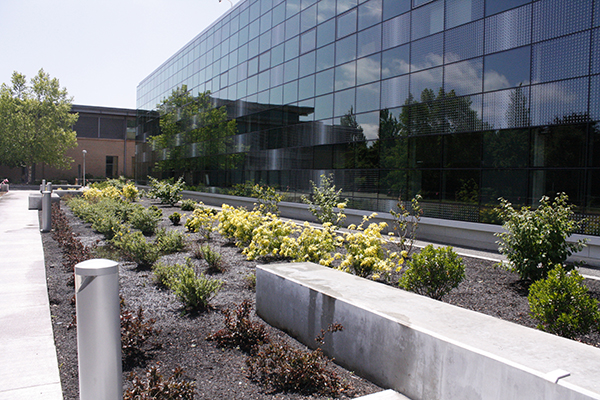This content was published: July 8, 2015. Phone numbers, email addresses, and other information may have changed.
Rock Creek’s innovative Building 7 project earns LEED Gold rating
Photos and story by Katherine Miller

Building 7’s east face features a double-panel spandrel glass wall with a weave pattern that adds visual depth and minimizes solar heat gain, thus helping maintain the building’s interior air temperature.
July 8, 2015
PCC Rock Creek has just struck gold. The first major project built by the 2008 voter-approved bond measure at that campus has earned a Gold rating from Leadership in Energy and Environmental Design (LEED), a certification program awarded by the U.S. Green Building Council and widely known as the industry standard for green structures.
To transform Building 7, nearly 18,000 square feet of inefficient space was removed from the ‘90s-era structure and replaced with a striking 26,000-square-foot addition, making room for new classrooms, study areas, and the Multicultural, Student Learning, Teaching Learning and Women’s Resource centers. The remainder of the building houses science and technology classrooms and labs, as well as campus administrative and office space.
The project was designed by Opsis Architecture and constructed by Fortis Construction, Faison Construction and Northwest Infrastructure for $10.6 million. The two-story building opened in March 2014.
According to Heather DeGrella, sustainability team leader with Opsis, energy modeling predicts that when compared to a similar building built to current national energy standards, the remodeled Building 7 will:
- use 36 percent less energy;
- save 33.3 percent in energy costs each year, or about $9,200;
- generate 67 percent fewer CO2 (When the building’s portion of the campus’ solar array is added in, that figure rises to 72 percent.)
Several features and strategies were used to achieve these savings, including:
Spandrel glass: The weave-patterned façade that covers the entire east face of the structure is made from double-paned glass, which is used to create a uniform appearance on building exteriors as well as to minimize solar heat gain. The glass treatment adds visual depth as well as helps to maintain interior air temperatures.
High-performance building envelope: Building 7’s “building envelope” – which includes the exterior walls and roof – uses efficient insulation: R-32 at the brick walls, R-23 at the spandrel glass, and R-45 at the roof. R-value is a measure of insulation’s ability to resist heat traveling through it; the higher the R-value, the better the thermal performance of the insulation.
In order to perform to its full potential, special detailing was used to create a continuous, unbroken layer of insulation where possible. This reduces the thermal bridging effect that building studs have in a wall; each piece of framing is a “thermal bridge” through the insulation that can conduct heat into or out of a building when the insulation is only located between the studs.
In addition to efficient insulation, the building envelope uses carefully detailed air and vapor barriers and sealants to protect against wind and rain, which can cause the loss of heated or cooled air.
“In fact, despite adding more than 26,000 square feet to the structure, the addition was able to tap into the existing boiler and chiller to heat and cool the building but without having to add any additional capacity to those systems,” said DeGrella.
Energy-efficient windows: The building has double-glazed, low-emissivity windows with a good solar-heat-gain coefficient (SHGC). SHGC indicates how much solar heat will be transmitted through the glass.
Natural ventilation: When conditions are right outside, the second floor is naturally ventilated through automatically operated windows. Turbine ventilators on the roof work in conjunction with these windows to bring in the air from outside and exhaust it through the roof.
Lighting: Unlike with traditional “occupancy sensors,” lights do not turn on automatically when a space is occupied. Rather, occupants must turn them on when desired, and “vacancy” sensors turn them off when a room is vacant. Sensors also continually measure ambient daylight and adjust electric lighting levels to reduce unnecessary use.
Lower-energy ceiling fans: Ceiling fans help people feel cooler when temperatures rise.
In terms of water use, DeGrella said that the project reduced the water used for irrigation by 50 percent, and the water used inside the building by 36 percent, over a conventional building.
“The exterior of the building is planted with native and drought tolerant plants,” she said. “The irrigation sensor uses a rain bird system to only water when necessary.”
The construction team also achieved exemplary performance for waste management by diverting more than 96 percent of the construction waste from the landfill.
The project earned additional LEED credits for: the campus’ four-acre learning garden; utilizing the solar array; developing a guiding policy for the campus on solid-waste management; and other initiatives.
DeGrella explained that the decision to add on to Building 7 instead of expanding the campus footprint fits with PCC’s Master Plan, which determines that building more densely in the campus core saves resources, helps protect water quality, and preserves the existing vegetation that helps give a campus its character.
By building in the central campus, the project also “saved land for green space and other important uses, such as the solar array,” she said. “Most importantly, it minimizes pedestrian travel distance and enhances campus community connection.”
Now that Building 7 is complete, Rock Creek Campus is focused on the improvements and addition to Building 5, which Opsis hopes will also earn a LEED Gold rating after it is completed in January 2016, DeGrella said.
PCC strives for a LEED Silver or better certification in buildings built under the bond program.
PCC’S 2008 voter-approved $374 million bond program is increasing opportunities for residents to access quality, affordable higher education close to where they live and work. Additional classrooms, updated equipment and technology, and advanced workforce training programs are helping to pave the way for future employment options. For more information, visit the bond website.
